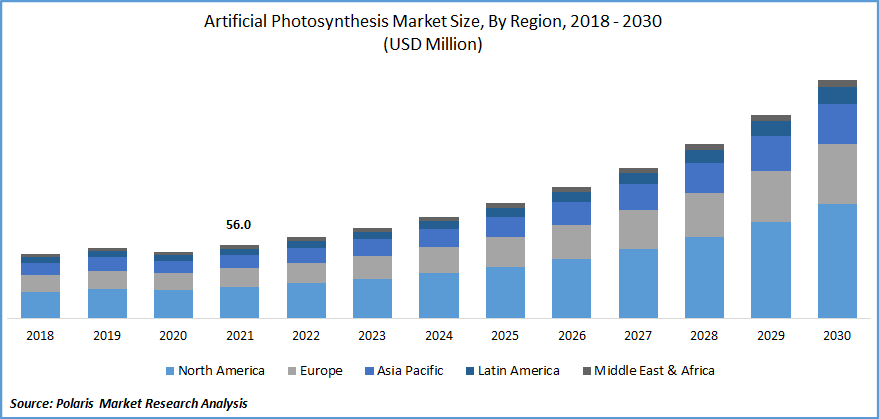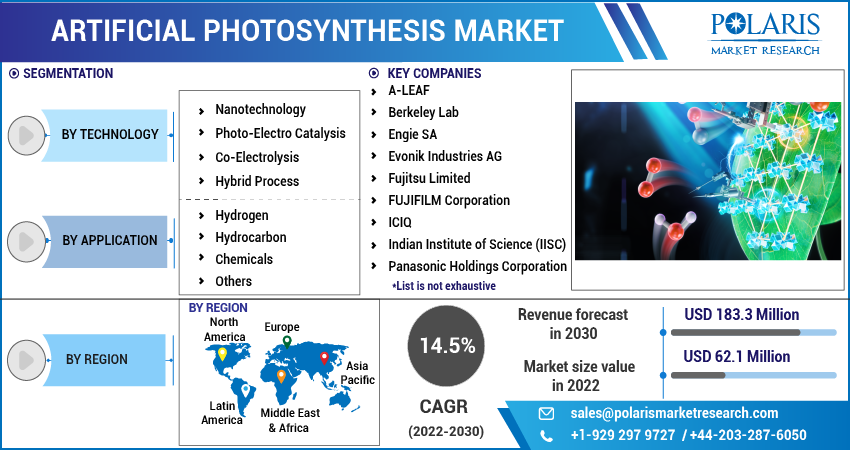
Artificial Photosynthesis Market Share, Size, Trends, Industry Analysis Report
By Technology (Nanotechnology, Photo-Electro Catalysis, Co-Electrolysis, Hybrid Process); By Application; By Region; Segment Forecast, 2022 - 2030
- Published Date:Oct-2022
- Pages: 114
- Format: PDF
- Report ID: PM2656
- Base Year: 2021
- Historical Data: 2018-2020
Report Outlook
The global artificial photosynthesis market was valued at USD 56.0 million in 2021 and is expected to grow at a CAGR 14.5% during the forecast period. Rising adoption of green technologies to meet the targets set by the governments for reducing greenhouse gas emissions and growing R&D activities to set zero-emission goal drives the market over the forecast period.

Know more about this report: Request for sample pages
Artificial is a method that imitates natural photosynthesis. This process is a biochemical reaction wherein living organisms and plants consume sunlight, carbon dioxide, and water to generate energy and oxygen from sugar.
Moreover, this technology is a more effective way of transforming solar energy into food. The possibility of using this technique for developing crop plants was also examined. Thus, it is a new technique for energy predicament. Therefore, in the coming years, there is a chance that acetate can be used to grow plants as an extra energy source to boost crop yields.
The artificial photosynthesis industry is highly competitive. Hence, expansion by commissioning new manufacturing plants is done after checking the financial viability of the venture, demand from the region, and the logistic infrastructure available.
Although the distribution network is quite strong in Europe and North America, the same does not hold for Asia, Africa, and Latin America. Moreover, stringent government rules & regulations, demanding worker’s unions, corrupt bureaucracy, and a poor transportation network prevent the companies from investing and expanding in a region and hence restrict market growth.
The COVID-19 pandemic influenced the global market. Due to the imposed lockdown worldwide, production was reduced by government organizations. Therefore, there was a huge reduction in demand for artificial photosynthesis. Moreover, since this is a man-made process and requires people to keep an eye on it, which was also stopped due to a shortage of labor and social distancing. Therefore, COVID-19 had a negative impact on the market.

For Specific Research Requirements, Request for a Customized Report
Industry Dynamics
Growth Drivers
The growth of the global artificial photosynthesis market is primarily driven by increased initiatives by governments across the world and rising research and development programs. Moreover, increasing adoption of green technology and sustainable development is also boosting the market demand.
Further, the artificial photosynthesis process through which food is produced could lead to a paradigm shift. Through this method, smaller land is required for food production in comparison with a traditional method. Thus, the impact of agriculture is lower on the environment.
A rise in adoption of green hydrogen is expected to result in greater demand for artificial photosynthesis. Countries across the world are turning toward green technologies and solutions to reduce carbon emissions and achieve their energy targets.
Report Segmentation
The market is primarily segmented based on technology, application, and region.
|
By Technology |
By Application |
By Region |
|
|
|
Know more about this report: Request for sample pages
Co-electrolysis segment is expected to hold a significant share
By technology, the market is segmented into nanotechnology, photo-electro catalysis, co-electrolysis, and hybrid process. Among this, the market for co-electrolysis segment is expected to hold a significant share during the forecast period.
Unified artificial photosynthesis blends high-efficiency Co2 and solar electrolysis at higher productivity to deliver optimal methods for carbon recycling. Co-electrolysis is a method in which both carbon dioxide and vapor is electrolyzed in a higher temperature of ~800°C using solid oxide electrolysis cells.
Moreover, photo-electrocatalysis is a robust method obtained from the blend of electrochemical techniques and heterogeneous photocatalysis. The technique is based on using a semiconductor unit illuminated by light momentum equivalent to or larger than its bandgap energy concurrently. Thus, this method of artificial photosynthesis facilitates distinct optimization of essential chemicals, along with light absorption.
Hydrocarbons accounted for the largest market share
By application, the market is segmented into hydrogen, hydrocarbon, chemicals, and others. Among these, hydrocarbon is expected to be the largest market in the artificial photosynthesis industry.
Artificial photosynthesis is expected to be a cost-effective, efficient energy storage source and requires no transportation system. Thus, hydrocarbon fuels are a very good substitute for fossil fuels. These hydrocarbon fuels also produce hydrogen fuels that are used in numerous applications.
North America region will lead the global artificial photosynthesis market by 2030
The North America region is expected to account for a larger share. This is due to the encouraging policies and programs initiated by the North American government for long-term modernization and development plans. Also, the increase in demand for sustainable solutions in the North American region is expected to stimulate market growth during the forecast period.
Further, the United States and Canadian provinces are in the stage of reducing carbon footprints and power generation through adoption of green technologies to meet the objectives put forward by the authorities for lowering greenhouse gas emissions. Moreover, the countries in the North American region are enhancing their investments in fuel generation technologies and innovative energy such as carbon recycling, fuel cells, and others.
Competitive Insight
The prominent market players operating in the global artificial photosynthesis market include A-LEAF, Berkeley Lab, Engie SA, Evonik Industries AG, Fujitsu Limited, FUJIFILM Corporation, ICIQ, Indian Institute of Science (IISC), Panasonic Holdings Corporation, Mitsubishi Chemical Holdings Corporation, Siemens Energy AG, Toshiba Corporation, Toyota Central R&D Labs., Inc., Twelve, and University of Toronto.
The major market payers operating in the global artificial photosynthesis market are investing in technological innovation and material advancements to cater to the growing demand for artificial photosynthesis worldwide. These companies collaborate with other market players, public organizations, and governments to leverage market opportunities and develop advanced solutions.
Recent Developments
In October 2021, Toshiba Corporation launched a carbon dioxide electrolyzer that utilizes artificial photosynthesis technology. They planned to develop projects for sustainable aviation fuel.
In September 2020, Evonik Industries AG and Siemens Energy AG entered to a partnership which uses water and carbon dioxide to create chemicals. This project has been funded by Federal Ministry of Education and Research (BMBF) with an amount of 6.3 million euros.
In May 2020, Evonik Industries AG and Beiersdorf agreed to create organic raw materials for care products, using carbon dioxide (CO2). Further, to reduce the carbon front print, Beiersdorf has planned to adopt artificial photosynthesis technology. This joint project of Beiersdorf and Evonik Industries AG has been financed by Germany’s Federal Ministry of Education and Research (BMBF) in €1 million.
In January 2020, ENGIE SA launched a new project CONDOR. This project was intended at manufacturing of fossil fuels by utilizing carbon dioxide (CO2) as the only source of energy. This involves a photosynthetic apparatus which is made of photoelectrochemical cell and carbon dioxide, which helps in generating syngas and O2.
Artificial Photosynthesis Market Report Scope
|
Report Attributes |
Details |
|
Market size value in 2022 |
USD 62.1 million |
|
Revenue forecast in 2030 |
USD 183.3 million |
|
CAGR |
14.5% from 2022 - 2030 |
|
Base year |
2021 |
|
Historical data |
2018 - 2020 |
|
Forecast period |
2022 - 2030 |
|
Quantitative units |
Revenue in USD million and CAGR from 2022 to 2030 |
|
Segments Covered |
By Technology, By Application, By Region |
|
Regional scope |
North America, Europe, Asia Pacific, Latin America; Middle East & Africa |
|
Key Companies |
A-LEAF, Berkeley Lab, Engie SA, Evonik Industries AG, Fujitsu Limited, FUJIFILM Corporation, ICIQ, Indian Institute of Science (IISC), Panasonic Holdings Corporation, Mitsubishi Chemical Holdings Corporation, Siemens Energy AG, Toshiba Corporation, Toyota Central R&D Labs., Inc., Twelve, Formerly Opus 12, and University of Toronto. |
